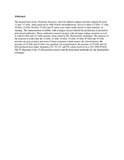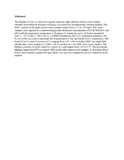Faculty of Science & Technology (FST): Recent submissions
Now showing items 4101-4120 of 4284
-
Immunization of rabbits with a midgut extract of the human body louse Pediculus humanus humanus: the effect of induced resistance on the louse population
(Department of Biochemistry, 1994)Resistance to human body lice, Pediculus humanus humanus L, induced by feeding on rabbits immunized with an extract of louse gut was studied. The mortality of lice fed on immunized rabbits was 73%, significantly higher ... -
Inhibition of bloodmeal digestion in glossina morsitans fed on rabbits immunized with tsetse midgut homogenate
(Department of Biochemistry, 1994)The efficacy of bloodmeal digestion in teneral Glossina morsitans centralis fed on rabbits immunized with tsetse fly midgut extracts was progressively monitored over a period of 96 hours. Flies fed on immunized rabbits ... -
TparvaDB: a database to support Theileria parva vaccine development
(Department of Biochemistry, 2011)We describe the development of TparvaDB, a comprehensive resource to facilitate research towards development of an East Coast fever vaccine, by providing an integrated user-friendly database of all genome and related data ... -
Characterization of body louse midgut proteins recognized by resistant hosts.
(Department of Biochemistry, 1996)The human body louse, Pediculus humanus, showed eighteen midgut proteins ranging between 12 and 117 kDa, when analysed by SDS-PAGE electrophoresis. Seven of them (12 kDa, 17 kDa, 29 kDa, 35 kDa, 40 kDa, 55 kDa and 97 kDa) ... -
Localization of immunogenic antigens on midgut of the human body louse Pediculus humanus humanus (Anoplura: Pediculidae)
(Department of Biochemistry, 1996)Immunogenic midgut antigens of the human body louse, Pediculus humanus humanus L., were localized using rabbit antisera against a louse-midgut extract followed by a 2nd antibody conjugated to either fluorescein or colloidal ... -
Immunization of rabbits with faecal extract of Pediculus humanus, the human body louse: effects on louse development and reproduction
(Department of Biochemistry, 1997)Immunization of rabbits with a faecal extract of the human body louse (Pediculus humanus) induced a high titre of specific IgG. The mean weight of blood taken by females fed on the immunized rabbits was significantly lower ... -
Partial characterisation of a trypanosome-lysing factor from the midgut of the desert locust, Schistocerca gregaria
(Department of Biochemistry, 2003)OBJECTIVE: Screening and biochemical characterisation of trypanosome-lysing factor (trypanolysin) from non-vector insect, Schistocerca gregaria. DESIGN: Laboratory based experiment. SETTING: Department of Biochemistry, ... -
Termites: a potentially large source of atmospheric methane, carbon dioxide, and molecular hydrogen
(Department of Chemistry, 1982)Termites may emit large quantities of methane, carbon dioxide, and molecular hydrogen into the atmosphere. Global annual emissions calculated from laboratory measurements could reach 1.5 x 10(14) grams of methane and 5 x ... -
The distribution of organochlorine pesticides in marine samples along the Indian Ocean coast of Kenya
(Department of Chemistry, 2002-11)The concentrations of organochlorine residues of lindane, aldrin, alpha-endosulfan, dieldrin, endrin, p,p'-DDE, p,p'-DDD and p,p'-DDT in samples of seawater, sediment, fish and seaweed from different locations along the ... -
Climatic, socio-economic, and health factors affecting human vulnerability to cholera in the Lake Victoria basin, East Africa
(Department of Chemistry, 2007)Cholera epidemics have a recorded history in the eastern Africa region dating to 1836. Cholera is now endemic in the Lake Victoria basin, a region with one of the poorest and fastest growing populations in the world. ... -
Analysis of heavy metals in water and surface sediment in five Rift Valley lakes in Kenya for assessment of recent increase in anthropogenic activities
(Department of Chemistry, 2007)The concentrations of heavy metals Ag, Cd, Co, Cr, Cu, Mn, Ni, Pb, Sn and Zn were analysed in water and surface sediments of five Rift Valley lakes Nakuru, Elementaita, Naivasha, Bogoria and Baringo in Kenya. The dissolved ... -
Copper binding by dissolved organic matter in freshwaters in Kenya
(Department of Chemistry, 2007)The binding of Cu2+ to dissolved organic matter in eight different natural water samples obtained from different locations in Kenya was studied by potentiometric titration method. The DOC contents of the eight natural water ... -
Sources of heavy metal input into Winam Gulf, Kenya
(Department of Chemistry, 2008)Water and surface sediment from rivers Kisat, Nyamasaria, Nyando, Sondu-Miriu, Kuja, Awach, Yala, and Nzoia, which flow into Winam Gulf, were analyzed for heavy metals in order to assess the influence of the catchment ... -
Levels of toxic metals in multisectoral samples from Winam Gulf of Lake Victoria.
(Department of Chemistry, 2009)In this study, the distribution and sources of inputs of trace metals including Cd, Cu, Zn and Pb from various sources as well as Fe which is widely used in the construction industry, into Winam Gulf of Lake Victoria were ... -
DDT and metabolites in fish from Lake Edward, Uganda
(Department of Chemistry, 2009)This paper presents results based on determination of residue levels of 1,1,1-trichloro-2,2-bis[p-chlorophenyl]ethane (DDT) and its metabolites in five fish species from Rwenshama landing site on Lake Edward, Uganda. The ... -
The effects of Mn2+, Ni2+, Cu2+, Co2+ and Zn2+ ions on pesticide adsorption and mobility in a tropical soil.
(Department of Chemistry, 2009)The adsorption behaviour of DDT in a tropical silt-clay soil from Kenya showed that addition of increasing metal ion concentrations from 10 to 100 microg/g of soil, reduced the % DDT adsorption in the soil by factors ranging ... -
Anthropogenic sources of heavy metals in the Indian Ocean coast of Kenya
(Department of Chemistry, 2009)Water and surface sediment samples from Rivers Sabaki, Ramisi and Vevesi that flow into the Indian Ocean coast of Kenya were analysed for heavy metals. The sediment concentrations of exchangeable cations (in microg/g) for ... -
Seasonal variability in cadmium, lead, copper, zinc and iron concentrations in the three major fish species, Oreochromis niloticus, Lates niloticus and Rastrineobola argentea in Winam Gulf, Lake Victoria: impact of wash-off into the lake
(Department of Chemistry, 2012)Trace metals Cadmium (Cd), Lead (Pb), Copper (Cu), Zinc (Zn) and Iron (Fe) were analyzed in edible portions of three main finfish species namely Lates niloticus, Oreochromis niloticus and Rastrineobola argentea sampled ... -
Assessment of polycyclic aromatic hydrocarbons in Lates niloticus, Oreochromis niloticus and Rastrineobola argentea as sources of human exposure in Kisumu Bay, Winam Gulf of Lake Victoria
(Department of Chemistry, 2012)The concentrations of polycyclic aromatic hydrocarbons (PAHs) in Lates niloticus, Oreochromis niloticus and Rastrineobola argentea from three beaches were assessed to establish whether they are sources of human exposure ... -
The Concentration of Heavy Metals: Zinc, Cadmium, Lead, Copper, Mercury, Iron and Calcium in Head Hair of Randomly Selected Sample of Kenya People
(Academic Press Elsevier. IntSchool of Physical sciences, 1982)Abstract not available






